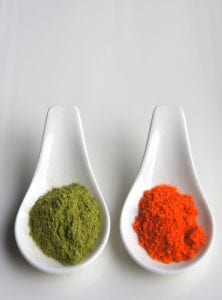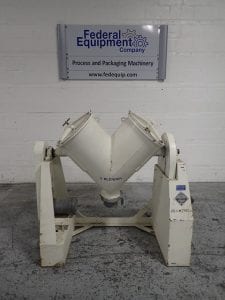By Adam Covitt, Vice President, Federal Equipment Company

The goal of powder blending is a homogeneous, or uniform, consistent mix of materials. The key to selecting a blender that will blend powders together into uniform mixes, also called “bulk solids,” are the material’s flow characteristics. Free-flowing powders are more likely to blend well together, but not all powders are free-flowing. Understanding the powder’s flow characteristics will help determine the best type of blender for the product.
Powder Flow Characteristics
Powders are the least predictable of all materials in terms of their ability to flow. A powder’s flow characteristics are determined by two sets of factors – the powder’s variables and external factors. Powder variables include the product’s bulk density, particle size, size distribution, shape, surface texture, cohesiveness, surface coating, and electro-static charge, among others. External factors include vibration, temperature, humidity, spurious electrical charges, aeration, container surface effects (or wall friction) and storage time. Addressing only one set of variables or partially addressing both sets of variables will lead to flow and, eventually, blend uniformity problems on the production floor. The flow characteristics will help identify the proper type of blender and the powder’s weight and density will help determine the size of the blender.
Blender Size
Blenders are volumetric, which means their sizes are usually measured in terms of their volume capacity such as cubic feet. Powders will not blend well (flow) if the blender is too full or too empty. A safe range of effectiveness is 35% – 65% of the overall capacity. The product’s flow characteristics will be the best indicator for the capacity range of each product mixed in the blender. As a rule of thumb, working capacity of a blender is usually determined as 50% of the total volume of the blender. For example, if a blender has an actual volume of 2 ft3, then the working capacity will be 1 ft3.
Blender Capacity Calculation
While blenders are generally sized according to volume, powders are usually measured according to density. Such measurements are either grams per cubic centimeter (gr/cc) or pounds per cubic foot (lbs/ ft3). Additionally, the request for blended materials usually comes in terms of a specific weight of material such as 15 kilograms (kg) without reference to volume or density. Powders can be very light (“fluffy”) or very dense which leads to different volumes of product at the same weight (think of a pound of feathers versus a pound of lead).
The proper blender size for the product is one that will have a working capacity within the effective range to achieve a uniform blend. The simple way to calculate the proper size versus the product density is to weigh a quart or liter of powder. 16 quarts or 15 liters of a product is equal to 1 ft3 at a density of 35 lbs/ ft3. Blenders sizes based on 35lbs/ ft3 at working capacity: 1 ft3 = 15kg; 2 ft3 = 30kg; 3 ft3 = 45kg; 5 ft3 = 75kg; 10 ft3 = 150kg; 20 ft3 = 300kg; 30 ft3 = 450kg; and 50 ft3 = 750kg. Size is not the only factor to consider, the type of blender is important as well.*
Blender Types

Twin-shell (or “V” blenders), double cone blenders and bin (or tote) blenders are all considered “random” style blenders. These types of blenders are also referred to as “open shell blenders.” They randomly mix powders that are already free flowing through the blender’s tumbling action. If the products are dense, an intensifier bar can be added which will force the powders to move inside the shell of the blender. Liquids may be added to the bulk solids mixture with a liquids bar. Intensifier bars can be overused which can result in particle break down for dry and friable powders or it can pack powders that are wet or cohesive (“sticky”).
Ribbon and paddle blenders are excellent ways to mix powders slowly and gently. In a ribbon blender a double-helix agitator will move materials towards the center of a trough with the outer blade while the inner blades move the materials towards the outside of the trough. Paddles are an alternate design that can be used for small batch

es relative to the working capacity of the blender and with friable materials.
High shear mixers are generally used for products which are considered immiscible, where the products to not generally form a homogeneous blend. The mixer operates by moving one phase into a continuous phase. The phases, or ingredients, can be solids, liquids or gases. The ingredients are moved with a rotor, or impeller, across other rotors or stators to produce a mechanical force called shear which forces the products to mix. Plow-style mixers are common high shear mixers that can be used for particle size reduction and to produce granules.
These are only a few, common-types of blenders available. There are many additional types of mixers that can be used for powder blending including planetary mixers, Nauta-style mixers and single and double-arm mixers – choices among many others which can be evaluated applying the same analysis of weight, capacity and flow characteristics. Powder flow characteristics and the weight of the product can be used to determine the proper type and size of the blender needed for the product. Analyzing the weight of the product can be used to estimate the working capacity required which determines the overall size of the blender needed. The flow characteristics will also determine whether the product can be blended in a random type blender, a ribbon or paddle blender, high shear mixer or some other type of blender.
